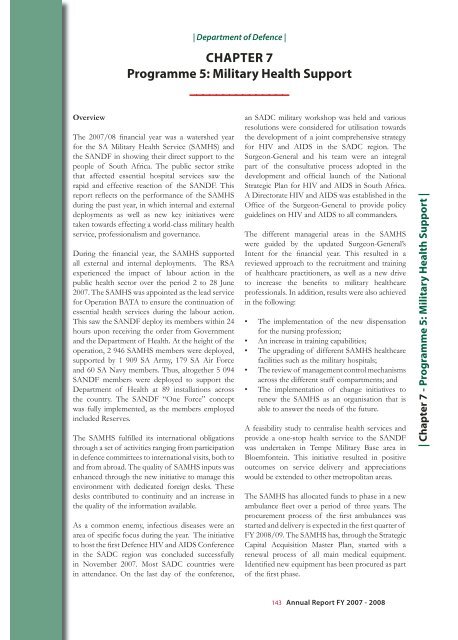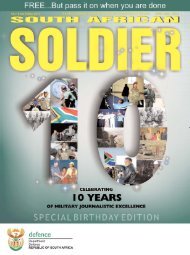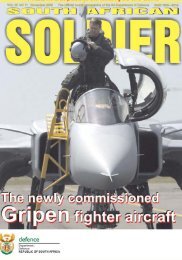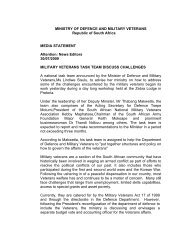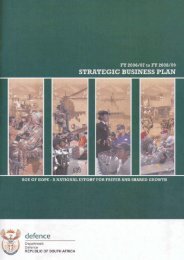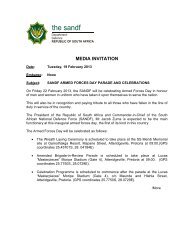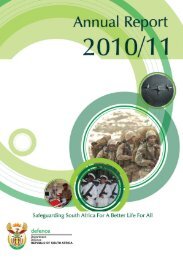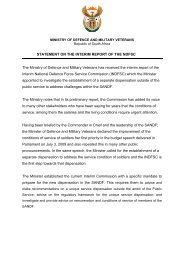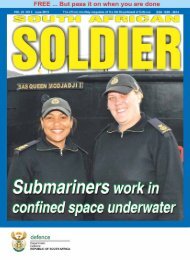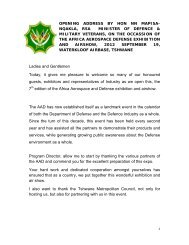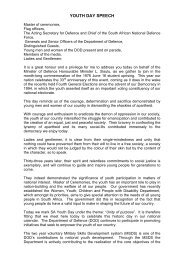Chapter 2 - P rogramme 1 - Department of Defence
Chapter 2 - P rogramme 1 - Department of Defence
Chapter 2 - P rogramme 1 - Department of Defence
Create successful ePaper yourself
Turn your PDF publications into a flip-book with our unique Google optimized e-Paper software.
Overview<br />
| <strong>Department</strong> <strong>of</strong> <strong>Defence</strong> |<br />
CHAPTER 7<br />
P<strong>rogramme</strong> 5: Military Health Support<br />
The 2007/08 financial year was a watershed year<br />
for the SA Military Health Service (SAMHS) and<br />
the SANDF in showing their direct support to the<br />
people <strong>of</strong> South Africa. The public sector strike<br />
that affected essential hospital services saw the<br />
rapid and effective reaction <strong>of</strong> the SANDF. This<br />
report reflects on the performance <strong>of</strong> the SAMHS<br />
during the past year, in which internal and external<br />
deployments as well as new key initiatives were<br />
taken towards effecting a world-class military health<br />
service, pr<strong>of</strong>essionalism and governance.<br />
During the financial year, the SAMHS supported<br />
all external and internal deployments. The RSA<br />
experienced the impact <strong>of</strong> labour action in the<br />
public health sector over the period 2 to 28 June<br />
2007. The SAMHS was appointed as the lead service<br />
for Operation BATA to ensure the continuation <strong>of</strong><br />
essential health services during the labour action.<br />
This saw the SANDF deploy its members within 24<br />
hours upon receiving the order from Government<br />
and the <strong>Department</strong> <strong>of</strong> Health. At the height <strong>of</strong> the<br />
operation, 2 946 SAMHS members were deployed,<br />
supported by 1 909 SA Army, 179 SA Air Force<br />
and 60 SA Navy members. Thus, altogether 5 094<br />
SANDF members were deployed to support the<br />
<strong>Department</strong> <strong>of</strong> Health at 89 installations across<br />
the country. The SANDF “One Force” concept<br />
was fully implemented, as the members employed<br />
included Reserves.<br />
The SAMHS fulfilled its international obligations<br />
through a set <strong>of</strong> activities ranging from participation<br />
in defence committees to international visits, both to<br />
and from abroad. The quality <strong>of</strong> SAMHS inputs was<br />
enhanced through the new initiative to manage this<br />
environment with dedicated foreign desks. These<br />
desks contributed to continuity and an increase in<br />
the quality <strong>of</strong> the information available.<br />
As a common enemy, infectious diseases were an<br />
area <strong>of</strong> specific focus during the year. The initiative<br />
to host the first <strong>Defence</strong> HIV and AIDS Conference<br />
in the SADC region was concluded successfully<br />
in November 2007. Most SADC countries were<br />
in attendance. On the last day <strong>of</strong> the conference,<br />
an SADC military workshop was held and various<br />
resolutions were considered for utilisation towards<br />
the development <strong>of</strong> a joint comprehensive strategy<br />
for HIV and AIDS in the SADC region. The<br />
Surgeon-General and his team were an integral<br />
part <strong>of</strong> the consultative process adopted in the<br />
development and <strong>of</strong>ficial launch <strong>of</strong> the National<br />
Strategic Plan for HIV and AIDS in South Africa.<br />
A Directorate HIV and AIDS was established in the<br />
Office <strong>of</strong> the Surgeon-General to provide policy<br />
guidelines on HIV and AIDS to all commanders.<br />
The different managerial areas in the SAMHS<br />
were guided by the updated Surgeon-General’s<br />
Intent for the financial year. This resulted in a<br />
reviewed approach to the recruitment and training<br />
<strong>of</strong> healthcare practitioners, as well as a new drive<br />
to increase the benefits to military healthcare<br />
pr<strong>of</strong>essionals. In addition, results were also achieved<br />
in the following:<br />
•<br />
•<br />
•<br />
•<br />
•<br />
The implementation <strong>of</strong> the new dispensation<br />
for the nursing pr<strong>of</strong>ession;<br />
An increase in training capabilities;<br />
The upgrading <strong>of</strong> different SAMHS healthcare<br />
facilities such as the military hospitals;<br />
The review <strong>of</strong> management control mechanisms<br />
across the different staff compartments; and<br />
The implementation <strong>of</strong> change initiatives to<br />
renew the SAMHS as an organisation that is<br />
able to answer the needs <strong>of</strong> the future.<br />
A feasibility study to centralise health services and<br />
provide a one-stop health service to the SANDF<br />
was undertaken in Tempe Military Base area in<br />
Bloemfontein. This initiative resulted in positive<br />
outcomes on service delivery and appreciations<br />
would be extended to other metropolitan areas.<br />
The SAMHS has allocated funds to phase in a new<br />
ambulance fleet over a period <strong>of</strong> three years. The<br />
procurement process <strong>of</strong> the first ambulances was<br />
started and delivery is expected in the first quarter <strong>of</strong><br />
FY 2008/09. The SAMHS has, through the Strategic<br />
Capital Acquisition Master Plan, started with a<br />
renewal process <strong>of</strong> all main medical equipment.<br />
Identified new equipment has been procured as part<br />
<strong>of</strong> the first phase.<br />
143 Annual Report FY 2007 - 2008<br />
| <strong>Chapter</strong> 7 - P<strong>rogramme</strong> 5: Military Health Support |


